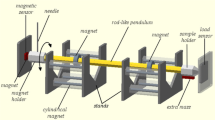Abstract
WHEN one metal slides over another, a measure of the amount of metal transferred from one surface to the other will give an indication of the amount of metallic adhesion occurring during sliding. Bowden and Moore1, using an electrographic analysis method, were able to detect quantities of copper transferred from a slider on to a platinum surface of the order of 10â-7 gm./mm.2. Using a radioactive flat surface, Sackmann, Burwell and Irvine2 measured, by means of a Geiger counter, the pick-up on a small spherical slider. More detailed information has been obtained in this laboratory by using a small radioactive slider and obtaining a contact photograph of the resulting track on a flat metal surface by means of a photographic plate placed directly on it.
Similar content being viewed by others
References
Bowden and Moore, Nature, 155, 451 (1945).
Sackmann, Burwell and Irvine, J. App. Phys., 15, 459 (1944).
Bowden and Leben, Proc. Roy. Soc., A, 169, 371 (1939)
Author information
Authors and Affiliations
Rights and permissions
About this article
Cite this article
GREGORY, J. Radioactive Tracers in the Study of Friction and Lubrication. Nature 157, 443–444 (1946). https://doi.org/10.1038/157443b0
Issue Date:
DOI: https://doi.org/10.1038/157443b0
- Springer Nature Limited





